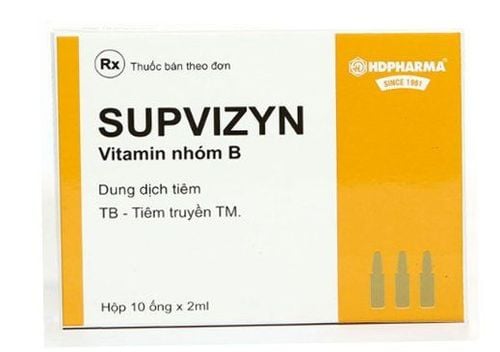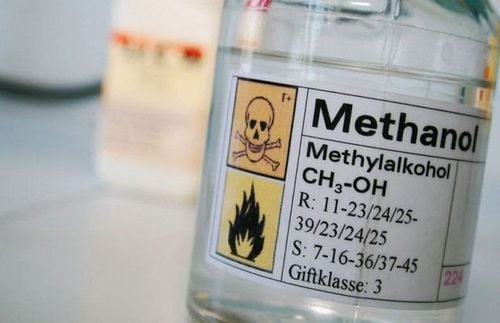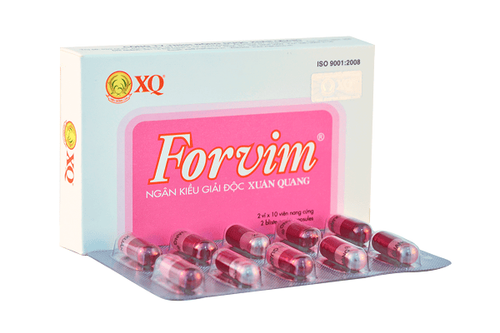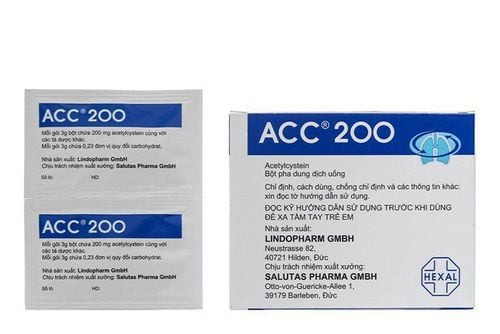This is an automatically translated article.
The article was written by Doctor Nguyen Thi Minh Tam - Specialist Doctor II - Head of Vinmec Royal City Clinic - Vinmec Royal City International ClinicWhen entering the body, methanol will convert into acids that cause cell damage, especially eyes, brain, blindness and even death.
1. Outline
Methanol (CH3OH): Industrial alcohol, not drinkable, is a component of gasoline, antifreeze, aromatic oils, wood alcohol, paint solvents, cleaning agents, industrial products.Methanol itself is not toxic, but its metabolites are very toxic.
Accidents caused by drinking alcohol mixed with methanol are increasing, death rate: 18 - 55% (research in the world).
Vietnam: Diagnosis and management are still difficult, because:
Methanol quantification test is not routine. Lack of specific antidote
2. Mechanism of toxicity
Formic acid: Causes cellular metabolic acidosis Inhibits cellular respiration Causes visual damage Central nervous system (CNS) damage. Toxicity to pregnant and lactating women.3. Clinical
Quiet phase: 0.5 – 4 hours. With Ethanol: 12-24 hours.Complete development:
Neurological: Consciousness disorder of many degrees. Severe: Coma, convulsions, mydriasis, and loss of light reflex (PXAS). Respiratory: Shortness of breath, rapid deep breathing, or slow breathing. Vision: Blurred vision, optic nerve inflammation. Metabolic acidosis: (18 - 48 hours late if taken with ethanol) In addition:
Gastrointestinal: Epigastric abdominal pain, gastrointestinal bleeding, acute pancreatitis (31.8%). Renal: Acute renal failure. Cardiovascular: Tachycardia, low blood pressure.
4. Subclinical
Arterial blood gases (ADV): Anion (>16 mEq/L) metabolic acidosis (BT: 12 -16). Blood ALT level > 10 mOsmol/L (measured ALT – Estimated ALT) Estimated concentration (if drinking Methanol alone): Blood Methanol (mg/dL) = ALT x 3.2 Quantitative: Blood Methanol: Sac gas (note the time of the test) > 20 mg/dL: Neurotoxicity. > 50 mg/dL: Fatal Formic acid, Formaldehyde: little clinical value. Cranial CT/MRI: Predominance in basal ganglia, dark duckweed nucleus, many lesions. Eyes: Papillary edema, congestion, hemorrhage, optic atrophy, irreversible loss of vision. Other tests: CTM, basic artery, basic biochemistry, chest X-ray, ultrasound, .... Serving treatment and monitoring patients.5. Diagnostic criteria
Recent consumption of alcohol or chemicals suspected of containing alcohol. Clinical: Breath smells of alcohol, RL consciousness, rapid deep breathing, hypotension, blurred vision. Tests for suspicion of Methanol poisoning: Acidosis CH, increase in SRB > 10 mOsmol/L, unexplained increase in Anion serum. The test found methanol in the blood.
Methanol trong máu là một trong những tiêu chuẩn chẩn đoán ngộ độc methanol
6. Classification of severity in Methanol poisoning:
| Triệu chứng | Nhẹ | Nặng |
| pH | ≥ 7,3 | < 7,25 – 7,3 |
| Viêm thị TK | Không | Có |
| Đe dọa dấu hiệu sinh tồn | Không | Có |
| RL nước, điện giải | Điều trị nội khoa | Phải lọc máu |
| Methanol máu | < 50 mg/ dL | ≥ 50 mg/ dL |
7. Treatment
a/ Respiratory Resuscitation: Ensure airway, oxygen, ventilation. Circulatory: IV fluids according to CVP (central venous pressure). Use vasopressors (when adequate fluid is restored) Maintain systolic blood pressure > 65 mmHg and urine output. Neurology: Intensive care and treatment of coma. Patients with convulsions: Diazepam... Activated charcoal gastric lavage has no role in the treatment of alcohol poisoning in general. Anti-acidosis: Severe: pH < 7.3 Very severe, life-threatening: pH < 7.1 and HCO3 < 10 mEq/L. Sodium Bicarbonate: pH < 7.3: 1-2 mEq/kg, IV every 4-6 hours. Adjusted according to the KMDM. Severe patients: Sodium Bicarbonate may be 800-1000 mEq/first 24 hours. Concentrated dose for the first 4-6 hours. Prioritize 4.2 %, 8.4% to assess fluid load (pay attention to blood potassium)Slow resolution of acidosis: Increases complications and mortality.
Hemodialysis: Removes Methanol and formic acid, corrects acidosis and electrolyte imbalance. Other treatment: Renal failure, electrolyte imbalance, hypoglycemia, eye damage, prolonged cerebral hypoxia. Supplementing with group B vitamins, especially in alcoholic patients. Treatment complications: Ethanol overdose, aspiration pneumonia, hospital-acquired infections, electrolyte imbalance. b/ Specific treatment Using specific antagonists (Antidote): The specific antagonists for Methanol are Fomepizole and Ethanol: 2 competitive inhibitors with Alcohol Dehydroenase. ANTIDOTE: ETHANOL Ethanol 10% : Intravenous catheter infusion: Bolus 0.8 g/kg – for 20 – 60 minutes Maintenance: 80 – 130 mg/kg/hour; 150 mg/kg/hour (alcoholic) Ethanol 20% orally: Bolus 0.8 g/kg – via nasogastric tube (4 ml/kg) Maintain 80 – 130 mg/kg/hour (0.4 – 0, 7 ml/kg/hr) 150 mg/kg/hr (0.8 ml/kg/hr) – alcoholism. Target: Blood Ethanol: 100 – 150 mg/dL It is not recommended to use ethanol > 30%. Dialysis patients: Double dose. Discontinue Ethanol when blood methanol is < 20 mEq/dL, blood form < 1.2 mg/dL, no complications (acidosis, CNS depression, no TT gap). Caution: Hypoglycemia, Ethanol overdose. ANTIDOTE: FOMEPIZOLE Bolus: 15 mg/kg, IV infusion – 30 minutes. Maintenance: 10 mg/kg every 12 hours (in patients on dialysis every 4 hours) Duration of administration: Blood methanol <20 mg/dL (with target organ damage), then < 10 mg/dL): End of TrCLS , full CH. Objective: The concentration of 4-MP in the blood sufficient to inhibit ADH is 0.8 mcg/ml. Need to combine more agonists: (rarely used). Folinic acid (Leucovorin) (Bd: Capoluck): The recommended dose is 1 mg/kg, diluted with 5% Glucose, IV 30-60 minutes, every 4-6 hours, until Methanol and Formate are no longer in the blood. . INDICATIONS FOR dialysis
Severe acidosis (pH < 7.25 - 7.3), unresponsive to medical treatment. Visual damage: Blurred vision, double vision, examination and ophthalmoscopy have lesions. RL vital signs after aggressive medical treatment. Acute renal failure. Electrolyte RL does not respond to medical treatment. Blood methanol > 50 mEq/dL.
Please dial HOTLINE for more information or register for an appointment HERE. Download MyVinmec app to make appointments faster and to manage your bookings easily.













